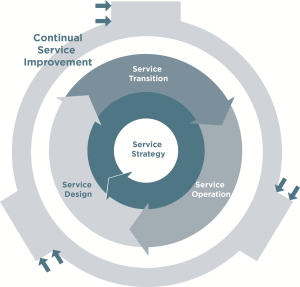When we attended Knowledge14 in San Francisco earlier this week, one thing we noticed is how amazingly far organizations have gotten in adopting IT Service Management (ITSM).
But while it does seem organizations have caught onto the fact that moving towards ITSM provides a lot of value, many have still not yet adopted or placed enough emphasis on the ITIL practices of Service Strategy and Service Design. This is a huge mistake, as ITIL offers valuable guidelines to service providers on the best ways to design and maintain services for the business.

Image from ITIL Service Design
One of those guidelines is to create a Service Design Package (SDP). It seems that many new service providers either neglect the SDP or create one that’s lacking in all the necessary elements. However, creating an SDP ensures your services are designed well, and according to the authors of ITIL Service Design “the better and more careful the design, the better the solution taken into live operation,” so creating a SDP is not a step you want to skip
The Service Design Package (SDP) follows a service through its lifecycle from initial proposal to retirement. It contains all the information required to manage an IT service. The SDP specifies the requirements from the viewpoint of the client (not IT) and defines how these are actually fulfilled from a technical and organizational point of view. When created properly, SDPs bring a lot of value to the business. A SDP…
- Improves the quality of services
- Improves decision-making
- Makes implementation of new or changed services easier
- Improves alignment of services to the business
- Makes service performance more effective
- Improves IT governance
- Makes ITSM more effective
- Reduces Total Cost of Ownership (TCO)
Once a SDP is completed, it is passed from Service Design to the Service Transition phase to provide all information required to develop the service solution, including a preliminary (i.e., intended) time-schedule for the Service Transition phase. Service Transition, Operation, and Continuous Improvement provide input to the requirements in the SDP, ensuring services get better as time goes on.
According to ITIL, a Service Design Package (SDP) should consist of the following contents:
Requirements
This section includes the agreed and documented business requirements, such as the problem statement, vision, and business objectives. The requirements also include service contacts, such as the business stakeholders and customer representatives. These are the high-level details with which the rest of the SDP must align; you want to make sure to deliver the right service to the right group of people.
Service Design
Service Design refers to the functional requirements describing the new or changed service and the Service Level Requirements (SLRs), including service and quality targets. Also, this section includes the operational management requirements for the new or changed service (e.g., supporting services and agreements, control, measuring and reporting). Lastly, this section should document the plan for the service’s transition, implementation, and operation. The Service Design section is very heavy in detail. In addition to the requirements for all service components and infrastructure, don’t forget supporting processes and procedures, as well as measurements, metrics, and reports.
Organizational Readiness Assessment
The information in this section will make up the plan to assess benefit, financial, technical, and resource aspects, and needs to include a description of the new skills, competencies, and capabilities required to transition and implement the new or changed service.
Service Lifecycle Plan
The last section includes the plan for each subsequent phase in the ITIL service lifecycle. This should include the required business processes, as well as a plan for communication and reporting. The Service Lifecycle Plan documents to manage related people, processes, and technology. It should also include timescales and quality targets for each phase. The Service Lifecycle Plan must include all details about service transition and operations focusing on the following:
- Service Transition Plan—document transition strategy, objectives, policies, risk assessment, and plans
- Service Operational Acceptance Plan—document interface and dependency management, as well as planning, events, reports, and service issues regarding the new service and final service acceptance
- Service Acceptance Criteria—document the acceptance criteria progression through each stage of the lifecycle
There are not many tools on the market that enable ITIL’s Service Strategy and Service Design. Enfocus Solutions provides software and services to IT service providers and managers looking to adopt ITIL best practices. Our software and services are designed to ensure services deliver value to the business by providing the capabilities to create a complete Service Design Package.
[cta id=”7640″]
